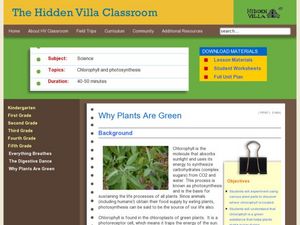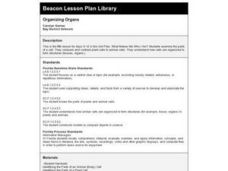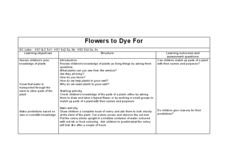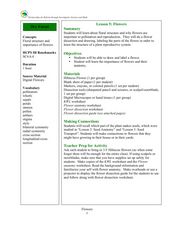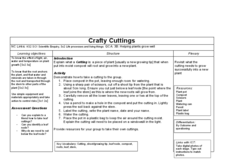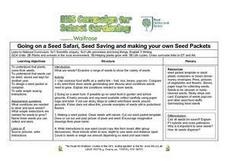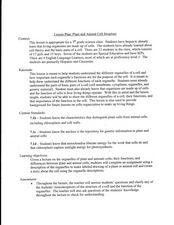Curated OER
Drawing a Plant Cell
For this cell structures worksheet, students draw a plant cell. Students draw and label all of the parts listed in the word bank. Students then identify each part by coloring it the color indicated in the word box.
HudsonAlpha Institute for Biotechnology
iCell
View attractive, three-dimensional models of an animal cell, a bacterium, or a plant cell. Suspended in a translucent, undulating cytoplasm, are all of the major organelles for life science learners to examine. They can zoom in, click on...
Curated OER
Why Plants Are Green
Young scholars discover the properties of chlorophyll in plants. In this plant biology lesson, students conduct an experiment to find where the chlorophyll in the plant is located. Young scholars are split into small groups and study...
Curated OER
Helping Plants Grow Well
Young scholars investigate the effect of water, temperature, and light on plant growth. In this plant lesson, students identify the parts of the plant and participate in an online activity. The website is included in this lesson plan.
Curated OER
Organizing Organs
Fifth graders research plant and animals cells and create a Venn Diagram to show the similarities and differences.
Curated OER
Life Cycles
Students explore the parts of a flower and pollination of flowers. In this plants lesson, students use an interactive whiteboard to label the parts of a plant and the functions of each part. Students complete a worksheet as an assessment.
Curated OER
Flowers to Dye For
Students observe biology by completing a plant experiment in class. In this botany lesson, students discuss the anatomy related to a plant and how roots and stems are necessary to its survival. Students utilize food coloring and examine...
Curated OER
What Do Parts Do?
Learners review the components of the scientific inquiry method. In groups, they identify and describe the components and functions of all of the parts of a plant. Using a diagram, they label the parts of the plant chosen and share...
Curated OER
Dry Forest: Flowers
Students explore botany by examining diagrams. In this plant reproduction activity, students define a list of plant vocabulary terms and identify plant anatomy from a diagram. Students complete several plant activity worksheets and study...
Curated OER
Crafty Cuttings
Students learn how to successfully plant a cutting. In this plant cutting lesson, students understand the steps of making a plant cutting and can explain them to others.
Curated OER
Roots, Stems, and Leaves
In this plant activity, learners review the structure and function of roots, stems, and leaves. This activity has 5 matching, 7 true or false, 4 multiple choice, and 10 fill in the blank questions.
Curated OER
Going on a Seed Safari
Students describe biology by identifying different plants in class. In this seed lesson, students discuss the process of how a plant grows from seed to leaves. Students attend a field trip to their garden or another park and collect a...
Curated OER
Plants and Animals
Students find common needs between plants and animals. In this plants and animals lesson students compare that both plants and animals need food and water. They also find the differences between plant and animal needs.
Curated OER
Plant Reproduction
Students identify the different parts and function of a flower's reproductive system. For this biology lesson, students explain how pollination works. They watch a video and practice labeling parts of both flower and leaf.
Curated OER
Flowers
Pupils study the parts of any flower and the conditions under which the plant thrives. They collect photographs and drawings to help create an accurate, realistic sculpture. They illustrate and label the flower parts and take photos of...
Curated OER
Plant Classfications
Seventh graders observe and discuss as a class the different types of vascular plants. They examine the different parts of the plant and some of the processes occurring in plants with activities accompanying.
Curated OER
How Can We Study the Differences in Animal and Plant Cells Using the Compound Microscope?
Young scholars examine their cheek cells with a compound microscope. They identify different parts of the cell. They compare and contrast animal and plant cells with the microscope as well.
Curated OER
Adopt a Tree
Young scholars adopt tress on their school campus for scientific observation purposes. In this tree science lesson, students adopt a tree at their school, observe the season changes for the tree, and create a PowerPoint presentation...
Curated OER
Plant Roots
Students discover the purpose of plant roots and how they move water through a vascular system. They conduct an experiment using colored water to observe the movement of water through the roots and stem of a plant in a controlled...
Curated OER
Parts of a Crinoid
Learners study the parts of a crinoid. In this parts of a crinoid lesson, students look at pictures of a crinoid fossil or examine an actual fossil if one is available. They match names to pictures of the parts in the second part of the...
Curated OER
Plant and Animal Cell Structure
Seventh graders identify the different parts and functions of the cell. In this biology lesson, 7th graders make a labelled diagram of either a plant or animal cell. They write a story about it.
Curated OER
Plant Cell Coloring
Students study a plant cell and its parts. In this cell organelle lesson students are to label parts of a plant cell and color them.
Curated OER
Cell Theory, Plant And Animal Cell Comparison
Tenth graders study plant and animal cells. In this investigative instructional activity students draw their own animal cells and label them.
Curated OER
Cells, Cells, Cells
Young scholars explore plant and animal cells. Using household items, students create a three-dimensional model of a plant or animal cell. Young scholars identify and label each cell part.


